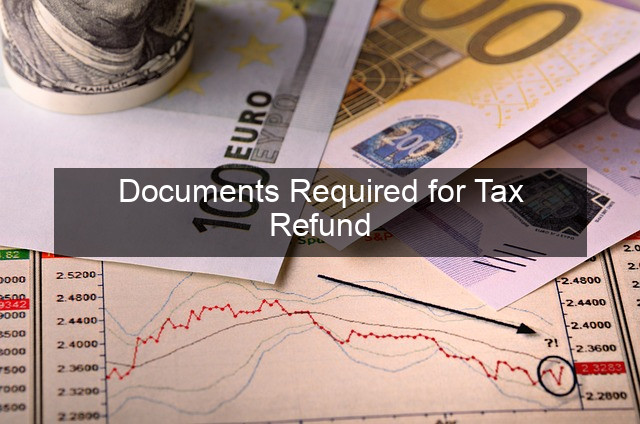Documents Required for Tax Refund
- Documents Required for Tax Refund
- Claiming Your Tax Refund: A Guide to Required Documents
- Essential Documents for Everyone
- W-2 Form: Your Income and Withholding Statement
- 1099 Forms: Reporting Other Income
- Form 1040: The Individual Income Tax Return
- Supporting Documentation for Specific Situations
- Itemized Deductions: Maximizing Your Refund
- Self-Employment: Navigating Business Taxes
- Choosing Your Filing Method
- E-filing: Fast and Convenient
- Mailing Your Return: The Traditional Approach
- Conclusion
- Frequently Asked Questions (FAQ)
- Common Tax Refund Questions

Claiming Your Tax Refund: A Guide to Required Documents
Tax season can be a daunting time, filled with forms, deadlines, and complex calculations. But the prospect of a tax refund offers a welcome light at the end of the tunnel. Getting your refund efficiently, however, hinges on having the right documentation prepared and ready to submit. This comprehensive guide will walk you through the essential documents required for a smooth and successful tax refund process. We’ll break down the various forms and supporting evidence you’ll need, depending on your individual circumstances, ensuring you’re well-equipped to navigate the tax landscape and claim what’s rightfully yours. Don’t let confusion or missing paperwork delay your refund – arm yourself with the knowledge you need to make tax season a breeze.
Essential Documents for Everyone
W-2 Form: Your Income and Withholding Statement
The W-2 form is the cornerstone of your tax return. It provides a summary of your earnings and the taxes withheld from your paycheck throughout the year. Issued by your employer, this document details your gross pay, federal and state income taxes withheld, Social Security and Medicare taxes, and other deductions. Ensure you receive your W-2 by the end of January, and keep it safe for your tax filing.
You’ll need a separate W-2 for each employer you worked for during the tax year. If you haven’t received your W-2 by mid-February, contact your employer immediately. If they’re unable to provide it, the IRS can assist you in obtaining the necessary information.
Accurately reporting your W-2 information is crucial for calculating your tax refund correctly. Any discrepancies can lead to delays or even an audit, so double-check all the details before submitting your return.
1099 Forms: Reporting Other Income
While the W-2 covers employment income, 1099 forms report various other types of income. These might include freelance earnings (1099-NEC), dividends and interest (1099-DIV and 1099-INT), government payments (1099-G), and more. Each variation of the 1099 form corresponds to a specific type of income, so be sure to gather all applicable forms.
Just like W-2s, 1099 forms are essential for accurately reporting your income and calculating your tax refund. Failing to report income documented on a 1099 can result in penalties and interest charges.
Keep track of all your 1099s throughout the year, as these smaller forms can easily get misplaced. A dedicated tax folder can help you stay organized and ensure you have everything you need when tax season arrives.
Form 1040: The Individual Income Tax Return
Form 1040 is the primary form used to file your federal income tax return. It’s where you’ll consolidate all your income and deductions to determine your tax liability or tax refund. The 1040 has undergone several revisions in recent years, so ensure you’re using the most current version available on the IRS website.
Depending on your financial situation, you may need to file additional schedules along with Form 1040. These schedules address specific deductions or credits, such as itemized deductions (Schedule A), business income (Schedule C), and capital gains (Schedule D).
Navigating Form 1040 can be complex, so consider using tax software or consulting a tax professional if you’re unsure about any aspect of the process.
Supporting Documentation for Specific Situations
Itemized Deductions: Maximizing Your Refund
If you choose to itemize deductions instead of taking the standard deduction, you’ll need supporting documentation. This may include receipts for medical expenses, charitable donations, property taxes, and mortgage interest. Maintaining organized records throughout the year will simplify the process of itemizing.
Itemizing can potentially lead to a larger tax refund, but it requires meticulous record-keeping. Ensure you have valid documentation for all claimed deductions, as the IRS may request proof.
Consider using a spreadsheet or dedicated software to track your expenses throughout the year. This will make compiling the necessary documentation much easier when tax time rolls around.
Self-Employment: Navigating Business Taxes
Self-employed individuals have unique documentation requirements. This includes records of income and expenses related to their business, such as invoices, receipts, and mileage logs. Accurate record-keeping is essential for calculating your profit or loss and determining your tax refund.
Self-employment taxes can be complex, so consulting with a tax professional is often beneficial. They can help you navigate the specific requirements and ensure you’re taking advantage of all applicable deductions.
Maintaining separate bank accounts and credit cards for business expenses can greatly simplify the process of tracking your income and deductions.
Choosing Your Filing Method
E-filing: Fast and Convenient
E-filing is the fastest and most convenient way to submit your tax return and receive your tax refund. Most tax software programs offer e-filing options, and the IRS also provides free e-filing services for eligible taxpayers.
E-filing reduces the risk of errors and ensures faster processing times compared to paper filing. You’ll also receive confirmation that your return has been received, providing peace of mind.
Choose reputable tax software or utilize the IRS Free File program for secure and reliable e-filing.
Mailing Your Return: The Traditional Approach
If you prefer the traditional method, you can mail your completed tax return and supporting documents to the IRS. Ensure you use the correct mailing address based on your state and whether you’re including a payment.
Mailing your return can take longer for processing and increase the risk of errors or lost documents. Keep copies of everything you submit for your records.
If you’re mailing a payment, consider using a certified mail service to track its delivery and avoid potential issues.
Conclusion
Securing your tax refund efficiently relies on proper preparation and organization. By gathering the necessary documents outlined in this guide, you can streamline the filing process and avoid unnecessary delays. Remember to keep meticulous records throughout the year, especially if you itemize deductions or are self-employed. Whether you choose to e-file or mail your return, double-check all information for accuracy to avoid potential complications. While the tax process can seem overwhelming, understanding the required documentation empowers you to take control and claim the refund you deserve. Don’t hesitate to seek professional assistance if you encounter complexities or have questions about your specific situation. By being proactive and informed, you can make tax season a much smoother experience.
Frequently Asked Questions (FAQ)
Common Tax Refund Questions
- Where can I find the latest tax forms and instructions? You can find all the necessary forms and instructions on the official IRS website: www.irs.gov.
- When should I expect my tax refund? E-filed returns are typically processed within 21 days. Paper returns can take significantly longer.
- What if I can’t find my W-2 form? Contact your employer immediately. If they can’t provide it, the IRS can assist you.
- What is the difference between a 1099 and a W-2? A W-2 reports employment income, while 1099s report other income types like freelance earnings or dividends.
- Do I need to keep copies of my tax documents? Yes, it’s crucial to keep copies of all tax documents for at least three years.
- Can I amend my tax return if I make a mistake? Yes, you can amend your return using Form 1040-X.
| Document | Purpose |
|---|---|
| W-2 | Reports wages and taxes withheld |
| 1099 | Reports various other income types |
| 1040 | The primary income tax return form |

